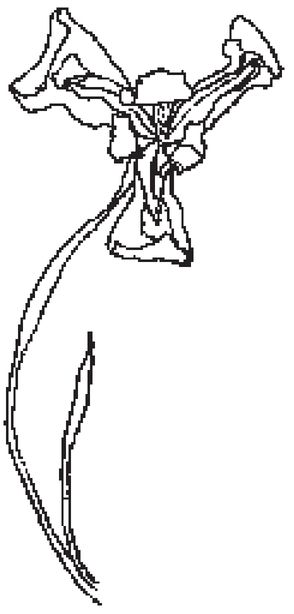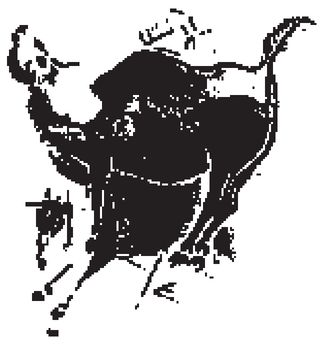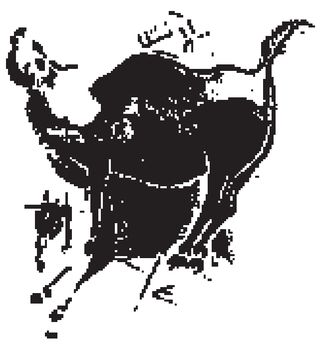The New Drawing on the Right Side of the Brain (4 page)
Read The New Drawing on the Right Side of the Brain Online
Authors: Betty Edwards

BOOK: The New Drawing on the Right Side of the Brain
13.02Mb size Format: txt, pdf, ePub
What kept me working at my “folk” theory (see the margin excerpt) was that, when put into practice, the results were inspiring. Students of all ages made significant gains in drawing ability and, by extension, in perceptual abilities, since drawing well depends on seeing well. Drawing ability has always been regarded as difficult to acquire, and has nearly always been additionally burdened by the notion that it is an extraordinary, not an ordinary, skill. If my method of teaching enables people to gain a skill they previously thought closed off to them, is it the neurological explanation that makes the method work, or is it something else that I may not be aware of?
I know that it is not simply my style of teaching that causes the method to work, since the hundreds of teachers who have reported equal success using my methods obviously have widely differing teaching styles. Would the exercises work without the neurological rationale? It’s possible, but it would be very difficult to persuade people to accede to such unlikely exercises as upside-down drawing without some reasonable explanation. Is it, then, just the fact of giving people a rationale—that any rationale would do? Perhaps, but I have always been struck by the fact that my explanation seems to make sense to people at a subjective level. The theory seems to fit their experience, and certainly the ideas derive from my own subjective experience with drawing.
In each edition of this book I have made the following statement:
The theory and methods presented in my book have proven empirically successful. In short, the method works, regardless of the extent to which future science may eventually determine exact location and confirm the degree of separation of brain functions in the two hemispheres.
I hope that eventually scholars using traditional research methods will help answer the many questions I have myself about this work. It does appear that recent research tends to corroborate my basic ideas. For example, new findings on the function of the huge bundle of nerve fibers connecting the two hemispheres, the corpus callosum, indicate that the corpus callosum can inhibit the passage of information from hemisphere to hemisphere when the task requires noninterference from one or the other hemisphere.
Meanwhile, the work appears to bring a great deal of joy to my students, whether or not we fully understand the underlying process.
A further complicationOne further complication of seeing needs mentioning. The eyes gather visual information by constantly scanning the environment. But visual data from “out there,” gathered by sight, is not the end of the story. At least part, and perhaps much of what we see is changed, interpreted, or conceptualized in ways that depend on a person’s training, mind-set, and past experiences. We tend to see what we expect to see or what we decide we have seen. This expectation or decision, however, often is not a conscious process. Instead, the brain frequently does the expecting and the deciding, without our conscious awareness, and then alters or rearranges—or even simply disregards—the raw data of vision that hits the retina. Learning perception through drawing seems to change this process and to allow a different, more direct kind of seeing. The brain’s editing is somehow put on hold, thereby permitting one to see more fully and perhaps more realistically.
This experience is often moving and deeply affecting. My students’ most frequent comments after learning to draw are “Life seems so much richer now” and “I didn’t realize how much there is to see and how beautiful things are.” This new way of seeing may alone be reason enough to learn to draw.

“The artist is the confidant of nature. Flowers carry on dialogues with him through the graceful bending of their stems and the harmoniously tinted nuances of their blossoms. Every flower has a cordial word which nature directs towards him.”
—Auguste Rodin
1
Drawing and the Art of Bicycle Riding

D
RAWING IS A CURIOUS PROCESS, so intertwined with seeing that the two can hardly be separated. Ability to draw depends on ability to see the way an artist sees, and this kind of seeing can marvelously enrich your life.
RAWING IS A CURIOUS PROCESS, so intertwined with seeing that the two can hardly be separated. Ability to draw depends on ability to see the way an artist sees, and this kind of seeing can marvelously enrich your life.
In many ways, teaching drawing is somewhat like teaching someone to ride a bicycle. It is very difficult to explain in words. In teaching someone to ride a bicycle, you might say, “Well, you just get on, push the pedals, balance yourself, and off you’ll go.”
Of course, that doesn’t explain it at all, and you are likely finally to say, “I’ll get on and show you how. Watch and see how l do it.”
And so it is with drawing. Most art teachers and drawing textbook authors exhort beginners to “change their ways of looking at things” and to “learn how to see.” The problem is that this different way of seeing is as hard to explain as how to balance a bicycle, and the teacher often ends by saying, in effect, “Look at these examples and just keep trying. If you practice a lot, eventually you may get it.” While nearly everyone learns to ride a bicycle, many individuals never solve the problems of drawing. To put it more precisely, most people never learn to see well enough to draw.

Fig. 1-1.
Bellowing Bison.
Paleolithic cave painting from Altamira, Spain. Drawing by Brevil. Prehistoric artists were probably thought to have magic powers.
Drawing as a magical abilityBellowing Bison.
Paleolithic cave painting from Altamira, Spain. Drawing by Brevil. Prehistoric artists were probably thought to have magic powers.
Because only a few individuals seem to possess the ability to see and draw, artists are often regarded as persons with a rare God-given talent. To many people, the process of drawing seems mysterious and somehow beyond human understanding.
Artists themselves often do little to dispel the mystery. If you ask an artist (that is, someone who draws well as a result of either long training or chance discovery of the artist’s way of seeing), “How do you draw something so that it looks real—say a portrait or a landscape?” the artist is likely to reply, “Well, I just have a gift for it, I guess,” or “I really don’t know. I just start in and work things out as I go along,” or “Well, I just
look
at the person (or the landscape) and I draw what I see.” The last reply seems like a logical and straightforward answer. Yet, on reflection, it clearly doesn’t explain the process at all, and the sense that the skill of drawing is a vaguely magical ability persists (Figure 1-1).
look
at the person (or the landscape) and I draw what I see.” The last reply seems like a logical and straightforward answer. Yet, on reflection, it clearly doesn’t explain the process at all, and the sense that the skill of drawing is a vaguely magical ability persists (Figure 1-1).
While this attitude of wonder at artistic skill causes people to appreciate artists and their work, it does little to encourage individuals to try to learn to draw, and it doesn’t help teachers explain to students the process of drawing. Often, in fact, people even feel that they shouldn’t take a drawing course because they don’t know already how to draw. This is like deciding that you shouldn’t take a French class because you don’t already speak French, or that you shouldn’t sign up for a course in carpentry because you don’t know how to build a house.
Drawing as a learnable, teachable skillYou will soon discover that drawing is a skill that can be learned by every normal person with average eyesight and average eye-hand coordination—with sufficient ability, for example, to thread a needle or catch a baseball. Contrary to popular opinion, manual skill is not a primary factor in drawing. If your handwriting is readable, or if you can print legibly, you have ample dexterity to draw well.
We need say no more here about hands, but about eyes we cannot say enough. Learning to draw is more than learning the skill itself; by studying this book you will learn
how to see.
That is, you will learn how to process visual information in the special way used by artists. That way is
different
from the way you usually process visual information and seems to require that you use your brain in a different way than you ordinarily use it.
how to see.
That is, you will learn how to process visual information in the special way used by artists. That way is
different
from the way you usually process visual information and seems to require that you use your brain in a different way than you ordinarily use it.
You will be learning, therefore, something about how your brain handles visual information. Recent research has begun to throw new scientific light on that marvel of capability and complexity, the human brain. And one of the things we are learning is how the special properties of our brains enable us to draw pictures of our perceptions.
Roger N. Shepard, professor of psychology at Stanford University, recently described his personal mode of creative thought during which research ideas emerged in his mind as unverbalized, essentially complete, long-sought solutions to problems.
“That in all of these sudden illuminations my ideas took shape in a primarily visual-spatial form without, so far as I can introspect, any verbal intervention is in accordance with what has always been my preferred mode of thinking. . . . Many of my happiest hours have since childhood been spent absorbed in drawing, in tinkering, or in exercises of purely mental visualization.”
—Roger N. Shepard
Visual Learning, Thinking,
and Communication,
1978
Visual Learning, Thinking,
and Communication,
1978
“Learning to draw is really a matter of learning to see—to see correctly—and that means a good deal more than merely looking with the eye.”
—Kimon Nicolaides
The Natural Way to Draw,
1941
The Natural Way to Draw,
1941
Gertrude Stein asked the French artist Henri Matisse whether, when eating a tomato, he looked at it the way an artist would. Matisse replied:
“No, when I eat a tomato I look at it the way anyone else would. But when I paint a tomato, then I see it differently.”
—Gertrude Stein
Picasso,
1938
Picasso,
1938
“The painter draws with his eyes, not with his hands. Whatever he sees, if he sees it
clear,
he can put down. The putting of it down requires, perhaps, much care and labor, but no more muscular agility than it takes for him to write his name. Seeing
clear
is the important thing.”
clear,
he can put down. The putting of it down requires, perhaps, much care and labor, but no more muscular agility than it takes for him to write his name. Seeing
clear
is the important thing.”
—Maurice Grosser
The Painter’s Eye,
1951
The Painter’s Eye,
1951
“It is in order to really see, to see ever deeper, ever more intensely, hence to be fully aware and alive, that I draw what the Chinese call ‘The Ten Thousand Things’ around me. Drawing is the discipline by which I constantly rediscover the world.
“I have learned that what I have not drawn, I have never really seen, and that when I start drawing an ordinary thing, I realize how extraordinary it is, sheer miracle.”
—Frederick Franck
The Zen of Seeing,
1973
The Zen of Seeing,
1973
The magical mystery of drawing ability seems to be, in part at least, an ability to make a shift in brain state to a different mode of seeing/perceiving.
When you see in the special way in which experienced artists see, then you can draw.
This is not to say that the drawings of great artists such as Leonardo da Vinci or Rembrandt are not still wondrous because we may know something about the cerebral process that went into their creation. Indeed, scientific research makes master drawings seem even more remarkable because they seem to cause a viewer to shift to the artist’s mode of perceiving. But the basic skill of drawing is also accessible to everyone who can learn to make the shift to the artist’s mode and see in the artist’s way.
When you see in the special way in which experienced artists see, then you can draw.
This is not to say that the drawings of great artists such as Leonardo da Vinci or Rembrandt are not still wondrous because we may know something about the cerebral process that went into their creation. Indeed, scientific research makes master drawings seem even more remarkable because they seem to cause a viewer to shift to the artist’s mode of perceiving. But the basic skill of drawing is also accessible to everyone who can learn to make the shift to the artist’s mode and see in the artist’s way.
Other books
Missing Link (The Finders Book 1) by Addison Jane
The Acolyte by Nick Cutter
Blandings Castle and Elsewhere by P. G. Wodehouse
Anna Finch and the Hired Gun by Kathleen Y'Barbo
IRISH FIRE by JEANETTE BAKER
Exclusive by Fern Michaels
Duke by Candace Blevins
Gone by Mallory Kane
The Children of Hare Hill by Scott McKenzie
When the Devil Drives by Caro Peacock